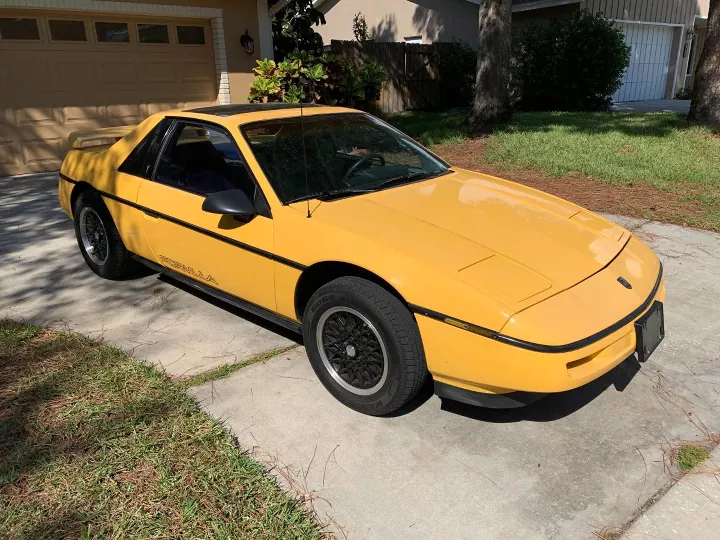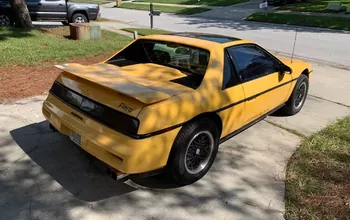Rare Rides: A Completely Stock 1988 Pontiac Fiero Formula (Part I)

Would you like a wedge-shaped economy coupe with sporty styling, a plastic body and a tendency to catch on fire? Well then, the choice is clear: Fiero, by Pontiac.
Today marks Part I of two for the Fiero, as there’s quite a bit of information to cover on this important Rare Ride. It’s not even the first time Rare Rides has touched on Fiero; that honor goes to the ’86 Zimmer Quicksilver. The Quicksilver was a different (expensive) take on the Fiero. It wore a lengthened body on the outside, and had a luxurious hand-crafted living room inside. But today’s subject is notable for a few different reasons, namely that it’s survived 32 years in stock condition.
The Fiero was a new kind of car for General Motors, as its engineers wanted to build a compact vehicle which would reinvigorate the Pontiac brand. It was the first mid-engine car in mass production from a U.S. manufacturer, and the first two-seat Pontiac since 1938. The goal with the Fiero was to appeal to customers who couldn’t spring for the full-fat V8 Corvette. Knowing execs were hesitant to approve a car that was even on the same plane as the Corvette, the Fiero team sold it to management by calling it an efficient commuter car.
After approval, they continued to develop Fiero as a sports car with a V6. It received a bespoke platform, the P-body, and utilized newly developed technology for its plastic body panels. Fiero was the only mass production vehicle to use the P platform, but General Motors held onto it for later use in the very limited production all-electric EV1. During development of the exciting new sports car, its lead designer was saddened to learn The General would not, in fact, spring for the development cost of an all-new aluminum block V6 as intended. There was a fuel crisis ongoing, and GM restricted the budget on the already expensive project. Besides, who needed a V6 when the 2.5-liter Iron Duke from the Celebrity was already available, and fit the application? The Fiero went on sale in 1984, and despite plenty of parts bin sharing it ended up a financial loser for GM. Each time they made a Fiero, Pontiac lost $2,000.
For the first two and a half years, the Fiero was only available as a notchback coupe. All versions carried the Iron Duke until 1985, at which point the fuel crisis was over, and consumers demanded more power in their coupes. GM conceded, and added a 2.8-liter V6 to the SE trim and the GT. Transmissions over the Fiero’s production included four- and five-speed manuals, and a three-speed automatic.
The first model year of Fiero was a rough one, and by 1987 there were more than 20 of them catching on fire each month. The burn rate was about one for every 508 cars produced that year. The cause was defective connecting rods in the engine, which would throw oil onto the hot exhaust and cause a slight fire. GM found about 40 percent of the rods produced at its Saginaw plant had defects. The company did recall all 244,000 four-cylinder Fieros, but not until January of 1990. Bit of a delay there on a very visible problem.
But the future of Fiero was not to be dampened by fire big issues. Stay tuned for Part II, where we’ll cover the second half of the Fiero’s run. It’s when the engineers got their say with Fiero instead of the accountants.
[Images: seller]

Interested in lots of cars and their various historical contexts. Started writing articles for TTAC in late 2016, when my first posts were QOTDs. From there I started a few new series like Rare Rides, Buy/Drive/Burn, Abandoned History, and most recently Rare Rides Icons. Operating from a home base in Cincinnati, Ohio, a relative auto journalist dead zone. Many of my articles are prompted by something I'll see on social media that sparks my interest and causes me to research. Finding articles and information from the early days of the internet and beyond that covers the little details lost to time: trim packages, color and wheel choices, interior fabrics. Beyond those, I'm fascinated by automotive industry experiments, both failures and successes. Lately I've taken an interest in AI, and generating "what if" type images for car models long dead. Reincarnating a modern Toyota Paseo, Lincoln Mark IX, or Isuzu Trooper through a text prompt is fun. Fun to post them on Twitter too, and watch people overreact. To that end, the social media I use most is Twitter, @CoreyLewis86. I also contribute pieces for Forbes Wheels and Forbes Home.
More by Corey Lewis
Latest Car Reviews
Read moreLatest Product Reviews
Read moreRecent Comments
- Eliyahu Oh, a nicer looking 2025 Camry!
- Analoggrotto Sell Canada to Mexico.
- MaintenanceCosts Just here to say thanks for the gorgeous picture of Vancouver, which may be my favorite city in the world.
- TheMrFreeze I don't doubt that trying to manage a company like Stellantis that's made up of so many disparate automakers is a challenge, but Tavares asking for so much money is simply bad form. With the recent UAW strike and the industry still in turmoil, now is not the time. And as somebody with a driveway full of FCA products, I'd just like to say how much I miss Sergio and FCA. At least with him Chrysler and Dodge stood a chance of long term survival...
- TheMrFreeze None of my cars are worthy of actual summer performance tires but our daily drivers do run all-seasons from about now until November, then winter tires the rest of the year because we're well into the snow belt. I always make sure the all-seasons I buy have good winter tire performance too, just in case we get caught with a very late or early winter storm



































Comments
Join the conversation
Many people got the wrong idea about the Fiero. It was never supposed to be a race car or something to take away sales from the Corvette. It was supposed to be a sporty (looking), reasonably good handling, economical commuter car – like an updated Opel GT. I used my 1985 Fiero GT for commuting for 160,000 miles and 14 years – including through all the extremely harsh winters, salt and potholes of Michigan. Though the suspension used “carryover” parts from other cars, I never had to replace a part. The power of the V6 matched Camaros, Trans Ams and Mustangs of the same year. If you used a Fiero for it’s intended purpose like I did (instead of as a sports car fantasy), you’d have been very pleased with it. No body rust. I had no issues except to replace the clutch after 80,000 – normal wear. I also owned a modified 1979 Corvette during those years for “sporty” driving like auto-crossing and drag racing. Use a car for it’s intended purpose and you’ll be happier.
Not sure where you got your fire data from. But here are the facts: Yes, some of the original valve cover gaskets in the 1984 Fiero 4 cylinder engines used to develop bad oil leaks. The oil leaks eventually found their way onto the exhaust manifold - like happens to almost any other engine in any other car. If enough oil built up and the engine oil level neglected, it would result in an engine compartment fire if the dopey owner didn't notice a smell, gradual loss of oil in the crankcase and basically just stupidly neglected the problem long enough. I had the optional V6 in my 1985 Fiero GT - a completely different engine. So, no such problem ever developed. The ‘fire’ issue pertained to ONLY 1984 4 cylinder models. Assorted manufacturing quality issues affected 5,000 of the 110,000 built. All 5,000 were recalled and corrected. Later all of the 110,000 were voluntarily recalled by GM (out of an abundance of precaution). Oil leak issues did not affect 1985-1988 4 and 6 cylinder models. The final tally: NHTSA recorded 167 fire incidents. GM independently logged a total of 260. Over its entire production run the Fiero’s fire safety record is ABOVE the average of ALL vehicles manufactured during those times. The Fiero’s 5-star crash safety rating because of it's "roll cage" space-frame construction and excellent energy absorption was only exceeded by a Volvo station wagon of the time. So according to NHTSA, there were 167 fires out of 110,000 vehicles in 1984. That's 0.15 % of 1984 production. 370,000 Fieros were built from 1984 to 1987 which would make engine fire incidents 0.045% of total production across all years. But the anti-American car bashing media of the time just wanted something shocking to write about... Kids today should not be writing critical articles about cars that they know nothing about.